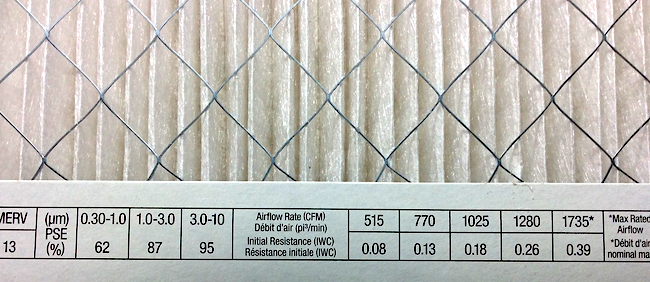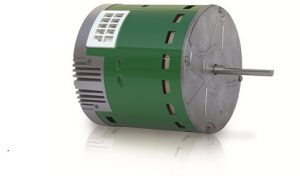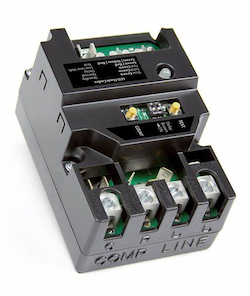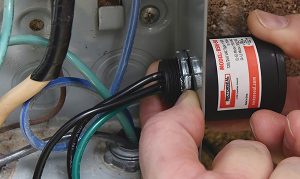
Upselling Residential HVAC Accessories
August 26, 2020 | By Ian McTeer
Studies show that consumers will often not only trust, but seek out advice from a professional, qualified and honest technician.
I can still remember most of the parts inventory stocked in my service van long before the day of electronic circuit boards and inverter drive compressors.
Here is a sample: box of thermocouples; several thermopiles; pilot burner/aluminum tubing/ferrules; millivolt thermostat/24-volt inexpensive thermostat; millivolt and 24-volt gas valve; quarter and third horsepower fan motors; selection of fan belts/4-in. adjustable drive sheave; shaft and bearings; replacement humidifier pads; selection of condenser fan motor and compressor capacitors; 30-lb. container of R-22; and other odds and ends such as thermostat wire, nuts/bolts/screws, Schrader valves and so on.
These items, intended mainly for a quick re & re then along to the next one. Some service contractors have been upselling items such as programmable thermostats, humidifiers and electronic air cleaners for many years. Technicians, in days gone by, were not noted for their sales prowess nor could many be bothered to spend extra time on the job upselling the customer to a newfangled programmable thermostat.
Nothing Happens Without a Sale
To say that the operation of a successful HVAC business in today’s cauldron of regulation, taxation and labour shortages is challenging only serves to camouflage the need of everyone in the residential HVAC marketplace to sell their company and its products every day.
Extracting as much revenue from projects typically means upselling smart thermostats, cabinet or bypass air filters, humidifiers and other devices at the front end so that installers can completely accessorize a job in one fell swoop. The so-called enhanced job ticket provides extra commission for salespeople and more profits for business owners.
HVAC businesses can also expect recurring revenue from the sale of maintenance contracts and equipment servicing. Modern HVAC technicians have become consultants, too. Studies show that consumers will often not only trust, but seek out advice from a professional, qualified and honest technician.
Many equipment sales are generated by techs factually demonstrating to frustrated customers that throwing any more money at a unit on its last legs simply is not worth it. When it comes to upselling accessories after the fact or to new service customers, contractors must decide what devices to sell and be sure everyone involved is professionally trained on how the device benefits any given customer. Techs, of course, must be trained to sell it, install it and commission it. It makes no sense to bulk up one’s inventory with devices few employees can or even want to sell.
Technician Sales
I have already mentioned that air filters for residential forced warm air systems are often sold up front; technicians aren’t likely to stock a 4-in. MERV 13 cabinet and associated duct fittings on their trucks. However, homeowners often ask techs for advice on better air filtration, humidification, HRV vs ERV and other indoor air quality related questions.
Certainly, a tech could make recommendations and even sell the IAQ job with an installation crew coming out later to complete the work. I’m thinking technicians are fielding COVID-19 questions every day now, and I hope they’re knowledgeable enough to make appropriate recommendations.
A few facts as of this writing: the air filter in a forced warm air system is not intended to filter-out biological agents, even though it likely does capture some bacteria and viruses. The filter’s primary job is to help keep critical heat exchanger surfaces such as the secondary heat exchanger, evaporator coil and blower wheel from loading-up with dirt.
Far too many residential buildings in Ontario, and likely elsewhere in Canada, were never designed for the greater airflows required of high efficiency gas furnaces, conventional add-on heat pumps or cooling systems. Inadequate return air ducting reduces the effectiveness of high efficiency systems and the addition of restrictive filters often causes equipment damage or poor performance. This MERV 13 filter (Figure 1, below)) will trap some small particles (62% efficient down to 0.3 microns) but the initial pressure drop in a 1200 cfm three-ton system is unacceptable.

Figure 1
Anyone intending to upsell high efficiency filtration must do a survey of the existing system to ensure a cabinet style high efficiency filter can work appropriately. In many cases, improved filtration might come from a HEPA bypass filter manufactured by companies like Amaircare, Five Seasons, Fantech and others.
I am pleased that our industry can promise homeowners significantly improved indoor air quality using several proven strategies. Relief from sometimes life-threatening allergens such as pollen, pet dander, dust and smoke continue to be a mainstay of our industry. Having said that, I am not sure we are ready to offer protection from dangerous viruses. Before COVID-19 took hold in North America, there were already several nasty influenza viruses circulating throughout the population. The Centers for Disease Control (CDC) in the United States said several strains of Influenza A(H1N1)pdm09 and Influenza B/Victoria had already taken many victims. Yet, most residential HVAC contractors made no effort to interdict these viruses.
As of this writing, it is still unknown if COVID-19 can spread throughout a building’s HVAC system. CDC tells us that the primary mechanism for transmission is through person-to-person contact with small droplets. It is also known that the virus spreads more rapidly in air when the relative humidity is below 40% or above 60%. Thus. improperly sized, short cycling cooling systems leaving excess moisture in the air along with poorly ventilated houses need to be corrected by our industry; however, repairs will be expensive.
Selling a homeowner on a filter capable of removing viruses from the air is not a wise pitch, in my view. Assuming the return air system is even capable of streaming droplets all the way to the filter, should unprotected homeowners or HVAC technicians be expected to change and properly dispose of spent filters potentially containing more viruses than a Level 4 laboratory? Viruses are not alive; they are more like a seed simply waiting for the right set of conditions to present themselves before sprouting their nasty business.
UV-C lights have a long history in our industry and can neutralize many kinds of microorganisms. UV-C disrupts virus DNA rendering it harmless. As a residential upsell, however, the contractor must carefully assess the air handling system including the evaporator coil and ductwork so that sanitizing reflectivity is maximized.
UV-C light is dangerous to the eyes and skin so safety mechanisms to ensure the lights are off during servicing are especially important. UV-C bulbs have a short lifespan, perhaps two years of effective service can be expected in most cases. Again, do the droplets containing the virus make it to the UV light? Perhaps a portable room UV-C filter would be a better upsell.
Another potential upsell that can effectively neutralize viruses along with mold, VOC’s, bacteria and can also oxidize odorous gases without generating any ozone is bipolar ionization. One unit, manufactured by Nu Calgon, mounts in the furnace or air handler blower compartment where the generated ions attach themselves to contaminants thus killing bacteria and neutralizing viruses.
The device allows for a reduced rate of ventilation in non-healthcare situations; however, it does produce some CO2 and water vapour that could, in some instances, throw a wrench into the target ventilation rate.
At this writing, it should be noted that neither the UV-C nor bi-polar ionization device manufacturers are making solid claims of providing protection from the SARS-COV-2 virus that causes the illness known as COVID-19. As a contractor, I would want to see positive results of accelerated testing along with the blessing of organizations such as ASHRAE, Health Canada and the CDC before aggressively upselling such products.
Fan Motor Upgrades
A popular upsell that can reduce electrical energy consumption by the HVAC system is an efficient fan motor such as the MARS Azure brushless or the Genteq Evergreen ECM’s (Figure 2, below). After upselling a better filtration system to catch dust, dirt, pollen and animal dander, the filter does its best work when the fan motor runs continuously. Yet, this upgrade is tricky because too many duct systems are already restrictive.

Figure 2
Curiously, PSC motors unload in the face of dirty filters and tight duct work, they use less energy whereas a programmed ECM will increase energy consumption to move the programmed amount of air. So, the contractor should be looking at duct renovations as an energy saving strategy before upselling expensive motors in some cases.
Many houses built during the boom years, starting in the late ‘60’s in Canada, have been renovated: better windows, doors, extra insulation and high efficiency heating systems have been installed. Yet, like a narrow, twisty gravel road is bad for an exotic sportscar, few older houses have had the proper duct renovations needed to handle the extra airflow requirements of high efficiency HVAC products.
Smart Thermostat & Companion Devices
Upselling smart thermostats to customers having WiFi makes good sense for everyone. Remote control capabilities through the internet allow homeowners to control their HVAC from anywhere, even allow for malfunction alerts to be directed to the contractor.
Additional devices like remote sensors and an outdoor temperature sensor provide extra comfort and convenience. Some smart thermostats incorporate internet hubs allowing other devices such as smoke alarms and water leak detectors to be incorporated into a smart home system. I especially like the data collection function of smart thermostats as daily and monthly run time data is invaluable for technicians looking for performance problems.
Electronic Contactor
Perhaps the weakest link in a residential air conditioner or conventional heat pump is the contactor switch. HVAC manufacturers have for many years incorporated very inexpensive contactors typically consisting of an unprotected single pole that suffers significant abuse from its general surroundings.

Figure 3
Although in a sealed electrical compartment, dust and dirt can get in and insects like ants and earwigs love to curl up inside the contacts apparently attracted by the magnetic field generated by the contactor coil. Dead bugs along with dust and dirt electrically insulate the contacts causing arcing, chattering, and damaging voltage drop, this means death in the afternoon for compressors. Even a one volt drop across the contacts is unacceptable. Upgrade the customer’s unit to a device like Emerson’s SureSwitch (Figure 3):
- It’s completely sealed, no bugs, dirt, water, debris can get inside
- The compressor is protected from voltage drop across the contact as well as brownouts and short cycling
- An on-board microprocessor helps to prevent contact pitting and welding
- Test and cycle count functions
Use ferrules at the heavy-duty lug-type line voltage connections and be sure to use an equivalent grade of wire should any existing components need to be moved and rewired.
Surge Protection
Consider upselling HVAC surge protective devices because modern equipment is full of expensive electronic controls (Figure 4, below). Furnace control boards, electronic txv’s, defrost controls, motor control modules, variable speed draft inducer controls and other devices are susceptible.
Considering my old service truck had a few hundred dollars’ worth of needed repair supplies, it is not likely that today’s service technicians are going to carry around a stock of high value inventory waiting for what amounts to an impulse sale, and only if the tech has the time.

Figure 4
Bryan Orr, co-founder of Kalos Services in Clermont, Florida talks about contractor sales: “Sales is something all employees need to be doing with every customer by discovering their needs, fears and desires and then providing them with solutions for which they will pay you.”
Some of the profits generated by multiple revenue streams help to build exceptional companies: there’s more money to better train all staff, money for top drawer pay and benefits, money for the best tools and equipment and money to help weather business related set-backs however caused.
Remember: Nothing happens without a sale.


 Ian McTeer is an HVAC consultant with 35 years experience in the industry. He was most recently a field rep for Trane Canada DSO. McTeer is a refrigeration mechanic and Class 1 Gas technician.
Ian McTeer is an HVAC consultant with 35 years experience in the industry. He was most recently a field rep for Trane Canada DSO. McTeer is a refrigeration mechanic and Class 1 Gas technician.


